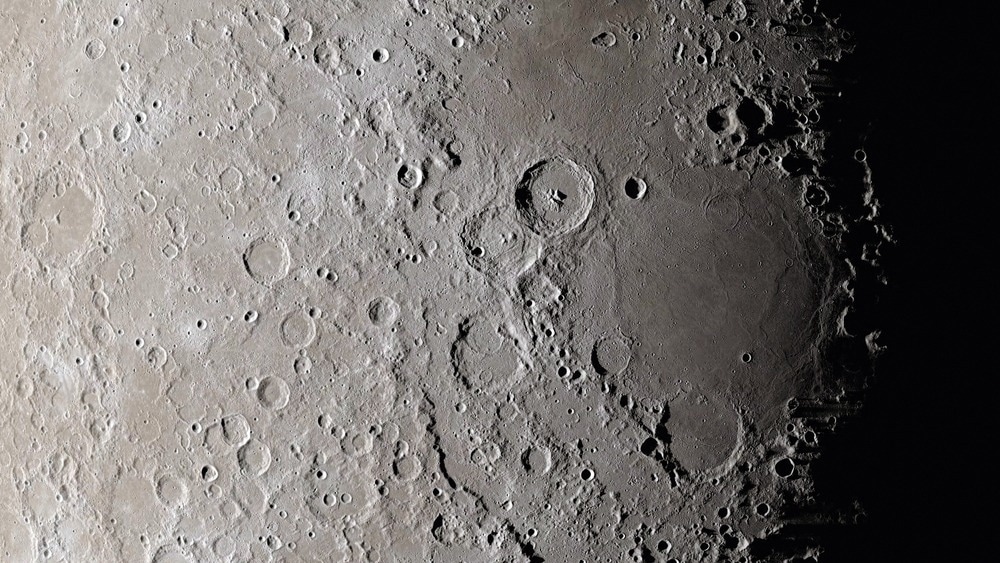A study published in the Journal of Applied Remote Sensing has proposed an approach for incorporating lunar spectral irradiance data to develop an enhanced lunar model for instrument radiometric calibration. Calibration by the resultant model improves the sensitivity and dependability of measuring trends.

Study: Multiple-instrument-based spectral irradiance of the Moon. Image Credit: Evgeniyqw/Shutterstock.com
Significance of Moon's Surface Spectrum Irradiance
Although the Moon is the closest celestial neighbor to Earth, our understanding of its spectral irradiance is less refined than the Sun and other bright stars such as Vega.
Since its creation, the environment on the Moon's surface has remained almost unchanged. The Moon's surface is accessible to Earth-orbiting spacecraft and is an exceptionally steady diffuse reflector.
The goal to monitor and increase understanding of the Moon's surface has resulted in increasingly stringent radiometric accuracy requirements for spacecraft remote sensing instruments. While instruments aboard spacecraft are calibrated against known standards in a lab, their responses in space may vary and may not be consistent over a long time.
The Moon's surface spectrum irradiance, as perceived by spacecraft from a lunar model, is required for calibration. The Robotic Lunar Observatory (ROLO) model, or the Global Space-based Inter-Calibration System (GSICS), has been used in lunar calibration, which compares an instrument-reported lunar irradiance to the actual irradiance.
However, the ROLO model has multiple drawbacks. For example, its error is estimated to be 5% or more, the libration components are constant across wavelengths, and 328 coefficients are required to give results at 32 irregularly spaced wavelengths, which are then convolved or interpolated to the required band.
Moreover, the ROLO model was designed to be polarization insensitive. However, satellite instruments utilizing scan mirrors are polarization sensitive.
Theoretically, one can calibrate using radiance for a particular portion of the Moon; however, this is difficult owing to the Moon's surface variability.
Using Data From Multiple Spacecraft and Surface Telescopic Observations to Improve the Spectral Lunar Irradiance Model
Data from several surface telescopic and spacecraft measurements are included in the model of the lunar spectrum irradiance. The calibration data was derived from 90,000 lunar images. In addition, an irradiance libration model generated from lunar orbiter measurements helped decrease the number of required coefficients.
The lunar calibration coefficient for each band is derived by assigning a single scaling factor to each band for several iterations.
Spectrometer data were averaged over 27 flat-topped synthetic bands aligned with intervening gaps and spacecraft bands for practicality and noise reduction.
High-resolution cylindrical maps of the Moon at various wavelengths were obtained from spacecraft orbiting the Moon and can be used to generate the libration model. The continuous solar spectrum was measured with a high-resolution variant of the TSIS-1 hybrid solar reference spectrum.
The objective of the lunar spectral irradiance model system is to use a new methodology and various data sources to develop an improved spectral lunar irradiance model in the solar reflectance range of 350 to 2400 nm.
Important Findings of the Study
A new methodology (SLIMED) for combining various sources of lunar spectral irradiance data has been devised and utilized to provide an enhanced lunar model for instrument radiometric calibration.
The SLIMED model is continuous in geometric and wavelength parameters. The proposed model addresses all the drawbacks of the ROLO model as it has 1/2 the magnitude residuals and 1/10 of the number of coefficients compared to the ROLO model.
SLIMED was created in Interactive Data Language (IDL), a programming language widely used in NASA. The SLIMED methodology, when implemented in an open language, can be utilized to provide an upgradable reference model for the lunar calibration community. However, it might rely on precise, traceable measurements of moon irradiance above the atmosphere.
When the SLIMED model is applied to 25 instruments and two additional models, it displays promising consistency and significant discrepancies. It indicates that from 400 to 870 nm, the MODIS, PLEIADES, OLI, and two surface observatories were calibrated using lab standards rather than stars.
The calibration of 26 instruments and two published models displayed significant biases, even though eight instruments agree within around 3% throughout the wavelength range of 400 to 840 nm.
Calibration of many instruments against a model reveals similarities and significant differences. Some ground-based instruments have fairly stable wavelength offsets. This means that something is wrong with the lunar calibration of some of the instruments, either in the radiation processing or in the observations.
It is necessary to investigate and address the reality of comparisons based on a single lunar model to achieve the full potential of the lunar calibration.
Reference
Hugh H. Kieffer. (2022). Multiple-instrument-based spectral irradiance of the Moon. Journal of Applied Remote Sensing. Available at: https://www.spiedigitallibrary.org/journals/journal-of-applied-remote-sensing/volume-16/issue-3/038502/Multiple-instrument-based-spectral-irradiance-of-the-Moon/10.1117/1.JRS.16.038502.full
Disclaimer: The views expressed here are those of the author expressed in their private capacity and do not necessarily represent the views of AZoM.com Limited T/A AZoNetwork the owner and operator of this website. This disclaimer forms part of the Terms and conditions of use of this website.